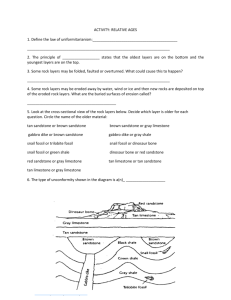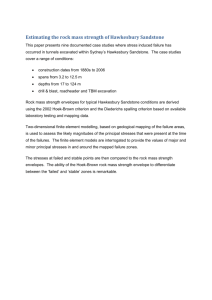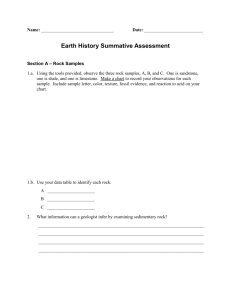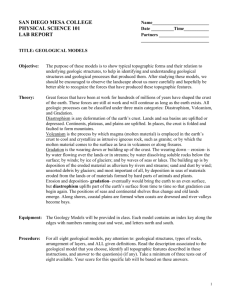answer key
advertisement
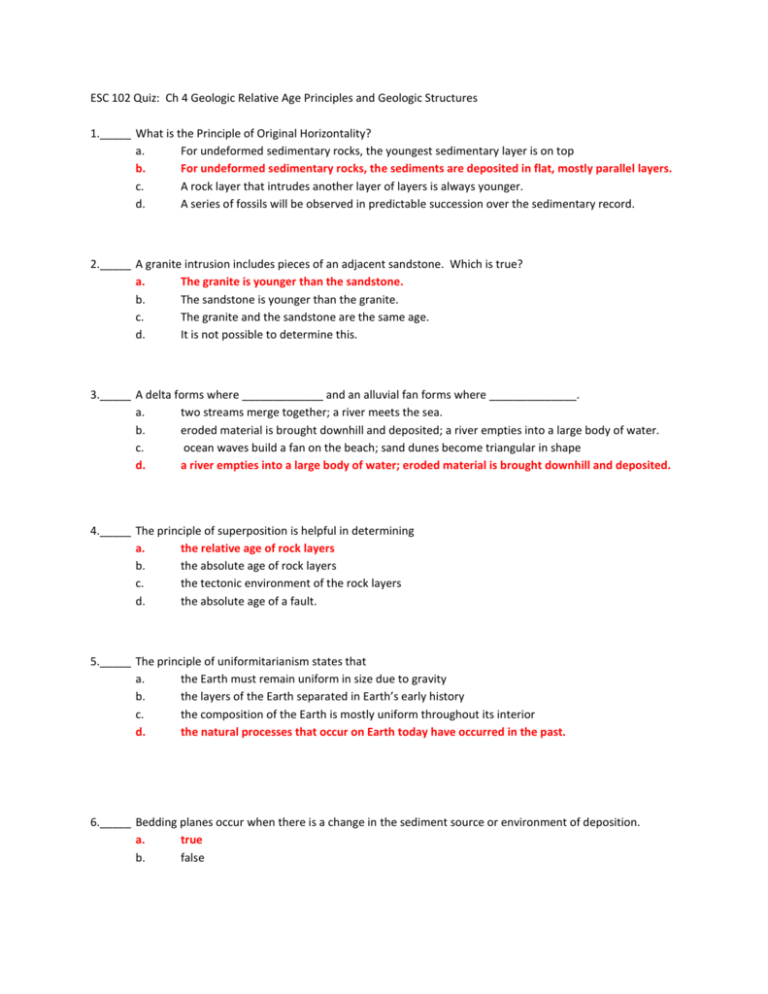
ESC 102 Quiz: Ch 4 Geologic Relative Age Principles and Geologic Structures 1._____ What is the Principle of Original Horizontality? a. For undeformed sedimentary rocks, the youngest sedimentary layer is on top b. For undeformed sedimentary rocks, the sediments are deposited in flat, mostly parallel layers. c. A rock layer that intrudes another layer of layers is always younger. d. A series of fossils will be observed in predictable succession over the sedimentary record. 2._____ A granite intrusion includes pieces of an adjacent sandstone. Which is true? a. The granite is younger than the sandstone. b. The sandstone is younger than the granite. c. The granite and the sandstone are the same age. d. It is not possible to determine this. 3._____ A delta forms where _____________ and an alluvial fan forms where ______________. a. two streams merge together; a river meets the sea. b. eroded material is brought downhill and deposited; a river empties into a large body of water. c. ocean waves build a fan on the beach; sand dunes become triangular in shape d. a river empties into a large body of water; eroded material is brought downhill and deposited. 4._____ The principle of superposition is helpful in determining a. the relative age of rock layers b. the absolute age of rock layers c. the tectonic environment of the rock layers d. the absolute age of a fault. 5._____ The principle of uniformitarianism states that a. the Earth must remain uniform in size due to gravity b. the layers of the Earth separated in Earth’s early history c. the composition of the Earth is mostly uniform throughout its interior d. the natural processes that occur on Earth today have occurred in the past. 6._____ Bedding planes occur when there is a change in the sediment source or environment of deposition. a. true b. false 7._____ Asymmetrical ripple marks most likely indicate that a. wind had to be the force that caused the ripples to form b. water had to be moving back and forth over sand c. water or wind had to be moving with a current over sand d. water was drying and causing cracks to form 8._____ A sedimentary layer containing fossils of whole shells in a fine-grained rock most likely formed a. in an alluvial fan b. on a high energy shore line c. in a low energy bay area d. in a glacial deposit 9._____ Straight nearly parallel grooves etched on the surface of a rock may indicate a. a glacier passed over the rock b. a strong current passed over the rock c. the grooves prove superposition d. major faulting is occurring 10.____ Catastrophism is the proposal that a. the end of the Earth is predictable from the rock record b. humans will cause the next extinction c. the Earth is very young and its surface has been formed by catastrophes d. the Earth was bombarded by meteorites over 4 billion years ago. ESC 102 _____ a. b. c. d. Quiz Ch 5,6 1. Which of the following is not likely to be a cause of marine transgression? global warming continental uplift increased sea floor spreading continental subsidence _____ 2. According to Walther’s law, if a marine transgression has occurred over an area of sedimentary rock deposits, how would a vertical sequence of these rocks appear? a. limestone (top), shale (middle), sandstone (bottom) b. sandstone (top), shale (middle), limestone (bottom) c. limestone (top), sandstone (middle), shale (bottom) d. sandstone (top), limestone (middle), shale (bottom) _____ 3. A small soft-bodied fish has a better chance of being fossilized than a large clam. a. true b. false _____ 4. An insect trapped in amber would be considered a. whole body fossil b. replacement c. altered remains d. trace fossil _____5. a. b. c. d. A steeply cross-bedded sandstone with sharp contacts would most likely have formed in a quiet lake in a glacial deposit in a windy desert in a submarine fan (turbidity current) _____ 6. The principle of uniformitarianism states that a. the oldest is on the bottom b. the earth is uniform throughout c. the present is the key to the past d. I don’t know, stop asking this question! _____7. a. b. c. d. A coprolite would be considered a whole body fossil a trace fossil a dinosaur unaltered remains _____ 8. A whole body fossil could best be preserved in a. ice b. lake bottom c. delta d. alluvial fan _____ 9. Graded bedding is likely to be associated with a. alluvial fan b. submarine fan c. fast-moving stream d. wind-blown sediments _____ 10. An alluvial fan is most likely to be formed in a a. high energy water environment b. low energy water environment c. high energy dry environment d. high energy water environment Quiz Ch 7,8 Answer with T for true and F for false: 1. __F___The theory of evolution is not widely accepted because there are too many gaps in the fossil record. 2. __T___ If evolution is true, then we would expect land-dwelling organisms on ocean islands to most closely resemble those of nearby continents rather than those on other distant islands. 3.___T__ Homologous structures in mammals are similar in bone structure but are modified for various purposes in different species. 4.__T___ Mendel’s experiments with garden peas during the 1860s demonstrated that variations in populations are maintained and may appear in future generations. 5. ___F__ Lamarck’s theory of inheritance of acquired characteristics still holds true today. 6. __F___ Natural selection predicts that the strongest, fastest and most intelligent species are most likely to survive. 7. __T___ Greenstone belts are evidence of Archean subduction zones. 8. __T___ There is no strong evidence of more than 1% of present-day free oxygen in Earth’s atmosphere during the Archean. 9.__T___ The rocks that make up the cratons are found on every continent on Earth today. 10.__F__ Earth’s hydrosphere formed when the moon’s gravity pulled waters to the surface. 11.__T__ Earth’s atmosphere formed from volcanic outgassing, but not until Earth’s magnetic field was formed.

